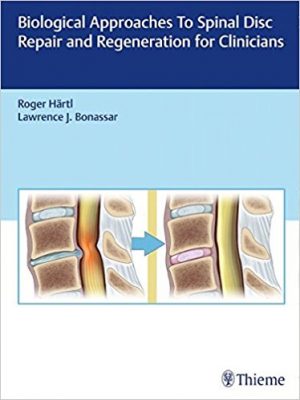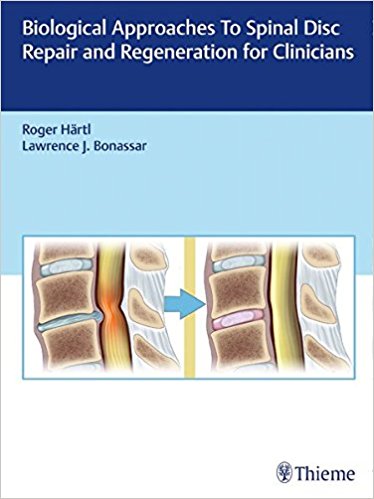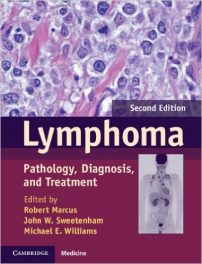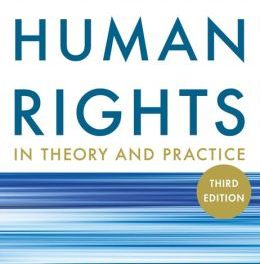 Editors: Roger Hartl, MD; and Lawrence J. Bonassar, PhD
Editors: Roger Hartl, MD; and Lawrence J. Bonassar, PhD
Publisher: Thieme – 204 pages, with 82 illustrations
Book Review by: Nano Khilnani
Low back pain (LBP) and low back discomfort are common complaints that general practitioners and spine specialists receive today from patients. These are generally caused by degenerative disc disease (DDD), and are leading causes of disability worldwide, which has a huge socioeconomic cost as well when employees fail to show up for work, both physical and mental in nature. In the United States alone, that cost is over $100 billion, the editors point out.
People whose parents have or had LBP are more prone to have it themselves. The editors Drs. Hartl and Bonassar point that prevention and treatment for any type of back, neck, or leg pain should begin with healthy-living basics that include eating healthy food, exercises that strengthen your core, and other physical activity like stretching that improves your flexibility.
They state that while they are successful in treating patients who suffer from pain due to nerve root compression (e.g. neurologic claudication with minimally- invasive ambulatory surgery, radicular pain due to disc herniation with outpatient procedures, and ‘mechanical back pain’ with spinal reconstruction and stabilization procedures), there are two sources of pain that they are “struggling to understand, adequately diagnose, and treat.”
- Muscle pain
- Invertebral disc (IVD) pain
They note that while muscle physiology has been extensively studied for decades, little is known about the physiology of IVD and cause of pain here. These and other matters are examined in this volume on the anatomy and physiology of spinal discs, and their repair and regeneration.
Sixty-four specialists in spine care and surgery, neurosurgery, orthopedics and orthopedic surgery, as well as biomedical engineering, musculoskeletal regeneration, and related fields authored the 21 chapters of this book. The contributors are from mainly the United States, but also from 12 other countries, namely Australia, Austria, Brazil, Canada, China, Colombia, Germany, Hong Kong, Italy, Japan, Saudi Arabia, and Switzerland.
The content in the chapters is organized round five Parts and two Appendices that we name below to give you an overview of the coverage of subjects in this book:
- Part I. Basics
- Part II. Experimental Techniques
- Part III. Treatment Strategies
- Part IV. Clinical Experience
- Part V. Outlook
- Appendix A: Abbreviations
- Appendix B: Terminology
In this contemporary (2017) and valuable volume on spinal disc repair and regeneration, you will find coverage of the following and related matters in its five Parts:
Part I –The human spinal disc including anatomy and physiology; disc disease and disc degeneration; imaging of healthy and diseased discs and their biomechanics.
Part II – The differences between animal and human spinal discs; the pros and cons of current animal models for preclinical development of biological therapies for low back pain; the clinical and experimental grading scales for disc degeneration and regeneration; disc regeneration: in vitro approaches and experimental results; and inter-vertebral disc: whole organ cultures
Part III – Biological treatment approaches: basic ideas and principles; learning from successes of tissue engineering strategies for cartilaginous disorders; treatment of degenerative disc disease and disc regeneration: proteins and genes; and treatment of degenerative disc disease / disc regeneration: growth factors and platelet-rich plasma; treatment of degenerative disc disease / disc regeneration: stem cells, chondrocytes and other cells, and tissue engineering; nucleus replacement and repair: autologous disc chondrocyte transplantation; and annulous fibroscus repair
Part IV – Summary of clinical trials with biological treatment approaches for spinal disease; total disc transplantation: current results and future development; what have we learned from mechanical total disc replacement?; regulatory overview: obtaining regulatory approval of a biological / cell product ;and what makes biological treatment strategies and tissue engineering for degenerative disc disease interesting to industry?
Part V – What will the future bring? Perspectives from around the world
Let’s take a look at the contents of chapter 8 – Invertabral Disc Whole Organ Cultures – in Part II of this book.
Abstract
8.1 – Introduction
8.2 – Historical Perspective
8.2.1 – Culture of Whole Invertebral Discs without Loading
8.2.2 – Culture of Whole Invertebral Discs under Loading
8.3 – Evidence-Based Results: Current Applications of Whole Organ Cultures
8.3.1 – New Surgical Techniques
8.3.2 – Annulous Fibrous Damage and Repair
8.3.3 – Nucleus Pulposus Damage and Repair
8.3.4 – Cartilage End Palate Damage and Repair
8.3.5 – Stem Cells: Trophic Factors, Differentiation and Migration
8.3.6 – Advantages and Limitations of Whole Organ Cultures Compared to In Vitro and In Vivo
8.4 – Future Directions of Whole Organ Cultures
8.5 – Conclusion
References
This book is important to practicing spine specialists, orthopedists, and neurologists, and those who are involved in surgeries of the spine, as well as those aspiring to practice these specialties.
It is a pioneering effort of the editors and authors in that it looks at how diseased spine discs are repaired and regenerated, and how spinal tissue is being created to replace diseased and degenerative discs.
Editors:
Roger Hartl, MD is Professor of Neurological Surgery, Director of Spinal Surgery, Director of the West Cornell Medicine Center for Comprehensive Spine Care, and Attending Surgeon at Weill Cornell Medicine at New York Presbyterian Hospital.
Lawrence J. Bonassar, PhD is Professor at Meinig School of Biomedical Engineering and Sibley School of Mechanical and Aerospace Engineering at Cornell University in Ithaca, New York.






